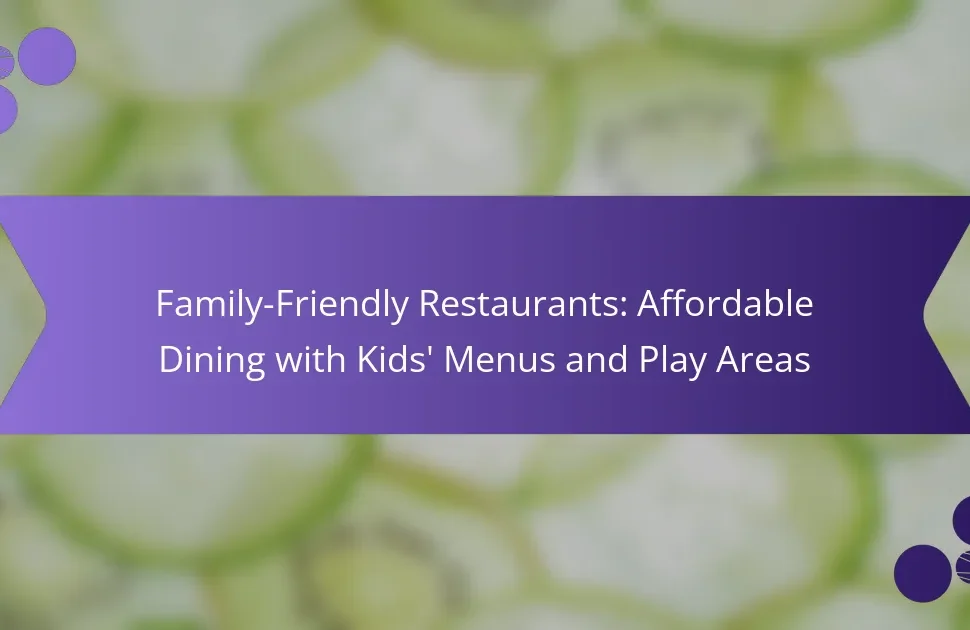
What are Mid-Range Culinary Experiences?
Mid-range culinary experiences are dining options that offer quality food and service at moderate prices. These experiences typically feature a diverse menu with unique dishes. They aim to provide a balance between casual and upscale dining. Diners can expect a comfortable atmosphere and attentive service. Often, these restaurants focus on fresh, locally sourced ingredients. The average price range for mid-range dining is usually between $15 to $40 per person. This category appeals to a wide audience, including families and food enthusiasts. Popular examples include bistros, gastropubs, and contemporary casual eateries.
How do Mid-Range Culinary Experiences differ from other dining experiences?
Mid-range culinary experiences differ from other dining experiences primarily in their balance of quality and affordability. These experiences typically offer higher quality food than casual or fast food dining, while remaining more accessible than fine dining. Mid-range restaurants focus on unique menus that highlight local ingredients and creative dishes. They often provide a more relaxed atmosphere compared to upscale establishments, making them suitable for a wider audience. The price range for mid-range dining usually falls between $15 to $40 per person, which is more budget-friendly than fine dining options. Additionally, mid-range culinary experiences often emphasize customer service and a pleasant dining environment, enhancing the overall experience. This combination of quality, price, and atmosphere sets mid-range culinary experiences apart from other dining options.
What defines a mid-range culinary experience?
A mid-range culinary experience is characterized by quality food, reasonable prices, and a comfortable atmosphere. These experiences typically feature a diverse menu that appeals to various tastes. The dining environment is often casual yet inviting, promoting social interaction. Service quality is generally attentive but not overly formal. Mid-range restaurants usually source fresh ingredients and may offer unique dishes or local specialties. According to a 2020 report by the National Restaurant Association, mid-range dining accounts for approximately 40% of the restaurant industry’s sales. This segment is popular among families and groups seeking a balance of value and quality.
What are the common characteristics of mid-range dining spots?
Mid-range dining spots typically offer a balance between affordability and quality. They provide a diverse menu with a range of options, catering to various tastes. The atmosphere is generally casual yet comfortable, encouraging a relaxed dining experience. Service is attentive but not overly formal, allowing for a friendly interaction. Pricing usually falls between fast food and fine dining, making it accessible to a wider audience. Many mid-range restaurants focus on using fresh, quality ingredients to enhance flavors. They often feature unique or regional dishes, setting them apart from typical chain restaurants. Overall, mid-range dining spots aim to deliver a satisfying experience without the high costs associated with upscale establishments.
Why are unique menus important in casual dining?
Unique menus are important in casual dining because they differentiate restaurants in a competitive market. They attract customers by offering distinctive flavors and dishes not found elsewhere. This uniqueness can enhance the dining experience, making it memorable. According to a 2020 survey by the National Restaurant Association, 70% of diners are more likely to visit a restaurant with a unique menu. Additionally, unique menus can foster customer loyalty, as diners seek out new and exciting experiences. By showcasing creativity and innovation, restaurants can also enhance their brand image. Ultimately, unique menus play a crucial role in driving customer engagement and satisfaction in casual dining settings.
How do unique menus enhance the dining experience?
Unique menus enhance the dining experience by offering distinctive dishes that cannot be found elsewhere. This variety stimulates curiosity and excitement among diners. Unique menus often reflect the chef’s creativity and cultural influences, providing a deeper connection to the cuisine. They can introduce diners to new flavors and ingredients, expanding their culinary horizons. Furthermore, unique menus can create a memorable experience that encourages repeat visits. According to a survey by the National Restaurant Association, 70% of diners are more likely to choose a restaurant with a unique menu. This indicates that unique offerings can significantly influence dining choices and satisfaction.
What role do unique ingredients play in creating a distinctive menu?
Unique ingredients are essential for creating a distinctive menu. They provide unique flavors that differentiate dishes from competitors. This uniqueness can attract customers seeking novel dining experiences. For example, using local and seasonal ingredients enhances freshness and supports local economies. Restaurants that incorporate rare spices or uncommon proteins can create signature dishes. Such offerings often lead to increased customer loyalty and word-of-mouth promotion. A distinctive menu can also reflect the chef’s creativity and culinary philosophy. Ultimately, unique ingredients elevate the overall dining experience, making it memorable for patrons.
What factors contribute to the popularity of casual dining spots?
Casual dining spots gain popularity due to their affordability, diverse menu options, and relaxed atmosphere. These establishments typically offer a wide range of cuisines, catering to various tastes and dietary preferences. The pricing strategy often positions them between fast food and fine dining, making them accessible to a larger audience. Additionally, casual dining venues frequently provide a family-friendly environment, attracting groups and families. Many also emphasize quality service and a comfortable dining experience, enhancing customer satisfaction. According to a National Restaurant Association report, 70% of consumers prefer casual dining for its value and experience. This combination of factors consistently draws patrons, contributing to the sustained popularity of casual dining spots.
How does ambiance affect the appeal of casual dining establishments?
Ambiance significantly enhances the appeal of casual dining establishments. A well-designed ambiance creates an inviting atmosphere that encourages patrons to relax and enjoy their meals. Elements such as lighting, decor, and music contribute to the overall experience. Studies indicate that 60% of diners consider ambiance crucial when choosing a restaurant. A pleasant ambiance can increase customer satisfaction and lead to repeat visits. Additionally, unique thematic decor can differentiate a casual dining spot from competitors. This differentiation can attract a specific target audience, further enhancing appeal. Overall, ambiance plays a vital role in shaping customer perceptions and experiences in casual dining.
What customer service aspects are crucial in casual dining?
Crucial customer service aspects in casual dining include attentiveness, friendliness, and efficiency. Attentiveness ensures that diners feel valued and their needs are met promptly. Friendly staff create a welcoming atmosphere, enhancing the overall dining experience. Efficiency minimizes wait times, which is essential in maintaining customer satisfaction. Additionally, knowledge of the menu allows staff to provide recommendations and answer questions. These elements contribute to repeat business and positive reviews, which are vital in the competitive casual dining sector.

What are some top-rated casual dining spots with unique menus?
Top-rated casual dining spots with unique menus include The Cheesecake Factory, known for its extensive menu featuring over 250 items. Another option is P.F. Chang’s, which offers a blend of Chinese and American cuisine with signature dishes. Yard House is recognized for its vast selection of draft beers and globally inspired dishes. Additionally, Maggiano’s Little Italy serves classic Italian-American meals in a family-style setting. These restaurants consistently receive high ratings for their diverse offerings and unique culinary experiences.
How can diners find the best casual dining experiences?
Diners can find the best casual dining experiences by researching online reviews and ratings. Websites like Yelp and TripAdvisor provide user-generated feedback. Diners should also consider recommendations from friends and family. Local food blogs often highlight hidden gems in casual dining. Social media platforms showcase popular spots through posts and stories. Visiting during off-peak hours can enhance the dining experience. Checking the menu online helps diners assess variety and pricing. Finally, seeking out restaurants with unique themes or concepts can lead to memorable meals.
What online resources are available for discovering unique dining spots?
Online resources for discovering unique dining spots include platforms like Yelp, TripAdvisor, and Google Maps. Yelp features user-generated reviews and photos, helping diners find local favorites. TripAdvisor offers ratings and detailed descriptions of restaurants worldwide. Google Maps provides location-based searches and user reviews for nearby dining options. Other resources include food blogs and social media platforms like Instagram, where food enthusiasts share their experiences. Websites like Eater and Zagat curate lists of standout eateries based on expert recommendations. These resources collectively help users explore diverse culinary experiences.
How do customer reviews influence the selection of dining spots?
Customer reviews significantly influence the selection of dining spots. They provide potential customers with insights into the quality of food and service. Positive reviews can enhance a restaurant’s reputation and attract more patrons. Conversely, negative reviews can deter customers from choosing a dining spot. Research indicates that 84% of people trust online reviews as much as personal recommendations. Additionally, 70% of consumers will leave a review if they are asked to do so. This data underscores the importance of customer feedback in shaping dining choices. Overall, reviews serve as a critical tool for consumers in the decision-making process.
What types of unique menus can be found in casual dining?
Casual dining establishments often feature unique menus that cater to diverse tastes. These menus can include themed cuisine, such as Italian, Mexican, or Asian fusion. Many casual dining spots offer seasonal menus that highlight local ingredients. Some restaurants provide customizable options, allowing guests to build their own dishes. Others may focus on health-conscious offerings, including vegetarian and gluten-free choices. Signature dishes often define unique menus, showcasing the restaurant’s culinary identity. Additionally, some casual dining venues introduce limited-time specials to create excitement. These menu variations enhance the dining experience and attract a wider audience.
What are some examples of globally inspired casual dining menus?
Examples of globally inspired casual dining menus include Mexican, Italian, and Asian cuisines. Mexican menus often feature tacos, enchiladas, and guacamole. Italian options typically include pasta dishes, pizzas, and risottos. Asian menus may offer sushi, stir-fries, and dumplings. These menus reflect diverse culinary traditions. They cater to a wide range of tastes and preferences. Many casual dining restaurants incorporate fusion elements. This blends flavors from different cultures into unique dishes.
How do seasonal menus enhance the dining experience?
Seasonal menus enhance the dining experience by offering fresh, high-quality ingredients. These menus reflect the natural growing cycles of produce, ensuring peak flavor and nutrition. Dishes made from seasonal ingredients often have a unique taste that is more vibrant than those made from out-of-season items.
Additionally, seasonal menus can create excitement and anticipation for diners. They encourage customers to return frequently to try new offerings. Research shows that 76% of diners appreciate menus that change with the seasons. This variety can keep the dining experience fresh and engaging.
Moreover, seasonal menus often promote local sourcing. This supports local farmers and reduces the carbon footprint associated with transporting food. By highlighting local ingredients, restaurants can foster a sense of community and connection with patrons.

What should diners consider when choosing a mid-range dining spot?
Diners should consider the quality of food, service, and ambiance when choosing a mid-range dining spot. Quality of food includes freshness, flavor, and presentation. Service should be attentive but not intrusive. Ambiance refers to the restaurant’s atmosphere, including decor and noise levels. Price points should align with the value offered. Diners should also check for menu variety to accommodate dietary preferences. Customer reviews provide insights into the overall experience. Location and accessibility play a role in convenience. Lastly, any special features, such as outdoor seating or live music, can enhance the dining experience.
How do dietary preferences impact the selection of casual dining options?
Dietary preferences significantly influence the selection of casual dining options. Consumers often seek restaurants that cater to their specific dietary needs. For instance, vegetarians will avoid establishments that primarily serve meat dishes. Similarly, those with gluten intolerance will prefer gluten-free options. Research indicates that 36% of consumers consider dietary restrictions when choosing a restaurant. This trend drives casual dining establishments to diversify their menus. Many now offer plant-based, gluten-free, and allergen-friendly dishes. Such adaptations attract a broader customer base. Consequently, dietary preferences shape menu offerings in the casual dining sector.
What are some popular dietary trends influencing casual dining menus?
Popular dietary trends influencing casual dining menus include plant-based options, gluten-free dishes, and health-focused meals. Plant-based diets are gaining traction due to health benefits and environmental concerns. Many casual dining restaurants now offer vegan and vegetarian choices. Gluten-free options cater to those with dietary restrictions or sensitivities. Health-focused meals emphasize fresh ingredients and lower calorie counts. Additionally, locally sourced ingredients are becoming more prevalent. These trends reflect consumer demand for healthier, more sustainable dining choices.
How can diners ensure their dietary needs are met at these restaurants?
Diners can ensure their dietary needs are met by communicating clearly with restaurant staff. They should inquire about menu options that cater to specific dietary requirements. Many restaurants provide allergen information and nutritional details on their menus. Diners can also request modifications to dishes to suit their needs. Utilizing apps or websites that list dietary-friendly restaurants can be beneficial. Additionally, reading reviews can provide insights into how well restaurants accommodate dietary restrictions. Engaging with the restaurant’s social media may reveal more about their offerings and practices. These steps help diners make informed choices that align with their dietary preferences.
What tips can enhance the casual dining experience?
To enhance the casual dining experience, focus on ambiance, service, and menu variety. A welcoming atmosphere sets the tone for enjoyment. Comfortable seating and appropriate lighting contribute to a relaxed vibe. Friendly and attentive service improves customer satisfaction. Staff should be knowledgeable about the menu and prompt in addressing needs. Offering a diverse menu caters to different tastes and dietary preferences. Including daily specials can keep the experience fresh and exciting. Additionally, incorporating local ingredients can enhance flavor and support community. These elements collectively create a memorable dining experience.
How can diners make the most of their visit to a casual dining spot?
Diners can make the most of their visit to a casual dining spot by planning their visit during off-peak hours. This allows for a more relaxed atmosphere and quicker service. Diners should also explore the menu thoroughly to discover unique offerings. Many casual dining spots feature signature dishes that highlight local ingredients. Engaging with staff can enhance the experience, as they often provide insights on popular dishes and specials. Sharing meals can also be beneficial, allowing diners to sample multiple items. Checking for promotions or happy hour deals can lead to cost savings. Finally, providing feedback can help improve the dining experience for future visits.
What are some best practices for trying new dishes in casual dining?
Start by reviewing the menu thoroughly. Look for descriptions that highlight unique ingredients or cooking methods. Consider asking the server for recommendations based on popular or signature dishes. Take note of any specials that may not be listed on the menu. Sharing dishes with dining companions allows for a wider variety of tastes. Start with smaller portions or appetizers to sample multiple options. Be open to trying ingredients you may not typically choose. Lastly, keep an open mind and enjoy the experience of discovering new flavors.
Mid-range culinary experiences encompass dining options that offer quality food and service at moderate prices, typically ranging from $15 to $40 per person. These establishments, such as bistros and gastropubs, focus on unique menus featuring fresh, locally sourced ingredients in a comfortable atmosphere. The article explores the defining characteristics of mid-range dining, the importance of unique menus in enhancing customer satisfaction, and factors contributing to the popularity of casual dining spots. Additionally, it highlights how diners can find the best experiences and ensure their dietary needs are met while enjoying diverse culinary offerings.




